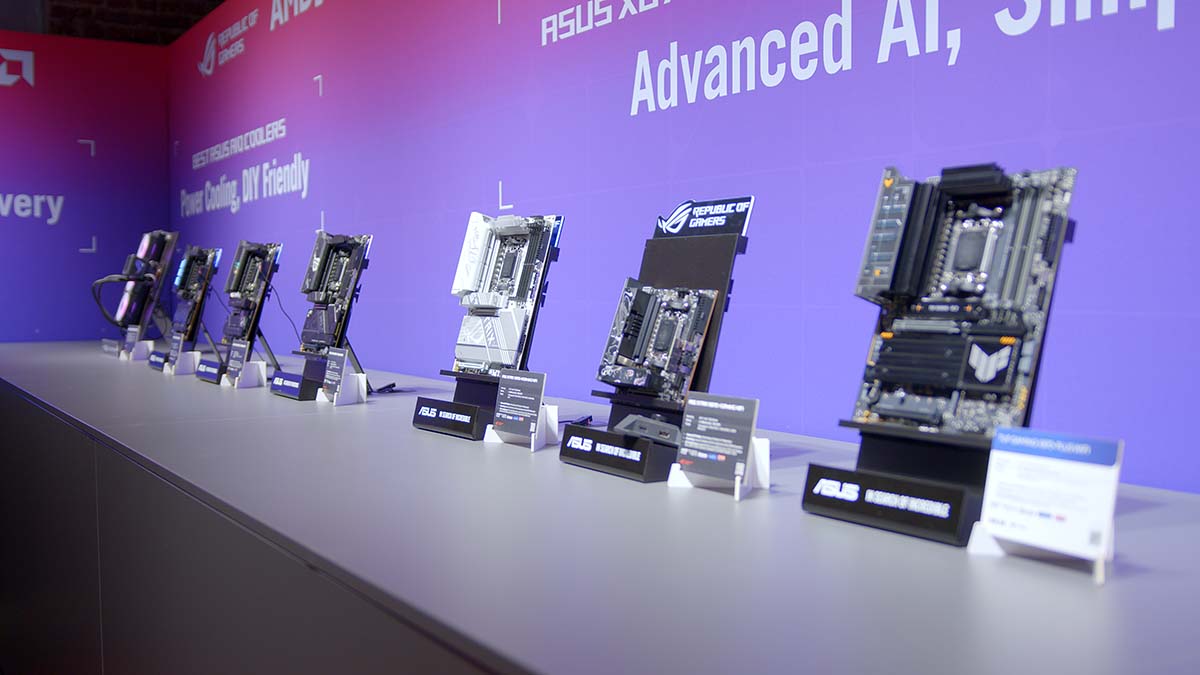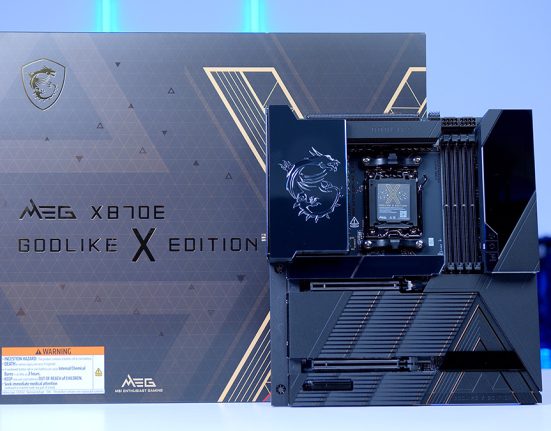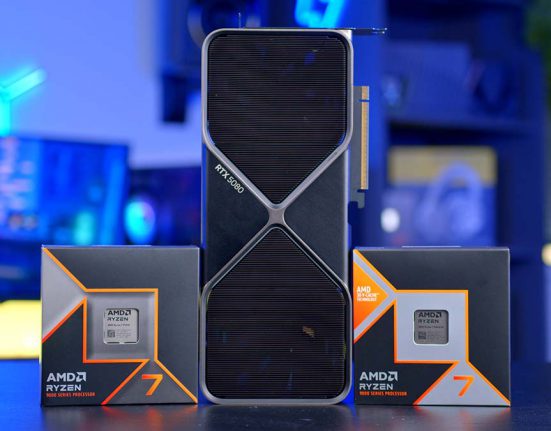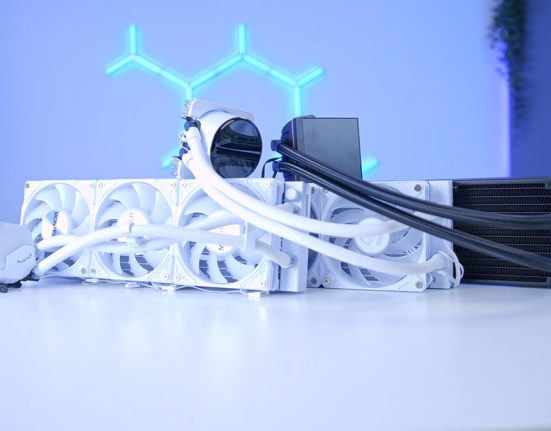ASUS has shown off brand new ranges of AMD X870 motherboards at Gamescom 2024, with many of these hitting the market in September. The central design premise of these boards is to work with the Ryzen 9000 range launched in early August. X870 motherboards utilise the same AM5 socket as their X670 counterparts but bring new and exciting features for gamers and enthusiasts to leverage more performance.
The ASUS boards shown at Gamescom have been previously seen on the X670 chipset, with the ROG Crosshair and ROG Strix ranges returning. Alongside these are boards from the TUF and ProArt Creator lines, with TUF boards geared towards budget price points and ProArt components aimed at enthusiast-level workstations.
Key Motherboard Features
The AM5 socket is returning for the X870 range, with AMD offering support through 2027 and beyond. This allows X670 board owners to switch to the Ryzen 9000 range with as little as a BIOS update. Previous generations aside, ASUS X870 motherboards have many features set to improve performance while providing plenty of expansion and upgrading room for prospective buyers.

Most notably, the X870 ranges feature a selection of one-click profiles to optimise overclocking, networking and cooling performance. These profiles are a surefire way to improve performance across the board. Whether you’re building a gaming PC and need improved network latency or assembling a workstation system designed to overclock Ryzen 9000 to the max, ASUS has you covered.
DDR5 memory support has improved, with JEDEC support jumping up to DDR5-5600 up from 5200, providing a speed boost. ASUS has also introduced NitroPath DRAM technology, which is available with the ROG Crosshair and ROG Strix X870E-E. This tech offers better durability and ensures quicker data transfers between RAM and the CPU, maximising performance.

WiFi 7 has arrived for AMD systems. With a supporting router, gamers can use WiFi 7, significantly increasing stability and wireless speeds versus WiFi 6E, providing a lag-free gaming experience. Every X870 chipset board also has USB 4 ports as standard and supports 40Gbps speeds. These ports can be used to daisy-chain multiple displays just through one cable!
ASUS ROG Crosshair X870E Hero
The ASUS Crosshair X870E Hero is the top-end option for building an enthusiast workstation or gaming PC. Dark hues dominate the board, with premium metal heatsinks covering the VRMs and M.2 slots.

Regarding features, the Crosshair X870E Hero features an 18+2+2 VRM power phase configuration designed to maximise overclocking performance across Ryzen 9000 CPUs. This is also one of the two new boards equipped with NitroPath DRAM technology, designed to push DDR5 memory to the maximum.
Expansion is excellent, with this board supporting dual PCI-E 5.0 x16 slots for graphics cards and five total M.2 slots, three of which are Gen5 and two Gen4. Enthusiasts can also leverage dual LAN ports, with 2.5 and 5 Gigabit Ethernet connectivity, or for those who prefer wireless, there’s also WiFi 7.
The IO selection is also great, with two USB4 ports, eight USB 3.2 Gen2 ports on the rear, two USB 3.2 Gen2x2 headers on the front, two USB 3.2 Gen1 ports, and two USB 2.0 headers. This board has a broad selection of USBs.

ASUS ROG Strix X870E-E Gaming WiFi
Next up is the ROG Strix X870E-E. This board, covered in plenty of ROG livery and RGB across the heatsinks, is designed for top-end gaming systems. Like its Crosshair sibling, the ROG Strix X870E-E features an 18+2+2 VRM set of power phases and a range of ROG overclocking technologies designed to maximise CPU performance. This also includes NitroPath DRAM, which maximises RAM capabilities.

This board is Gen5 ready, featuring a single PCI-E 5.0 slot for the next generation of graphics cards, alongside three Gen5 M.2 slots and two Gen4 SSD slots, so there’s ample expansion.
WiFi 7 and 5 Gigabit LAN are the networking options on this board, providing blazing-fast speeds and latency in competitive online games. Rear IO is incredibly bountiful, and we see two USB 4 ports, a single USB 3.2 Gen2x2 Type-C port that supports 30W power delivery charging, and ten USB 3.2 Gen2 ports, for a total of thirteen.
The front IO selection is just as strong, with the ROG Strix X870E-E featuring a USB 3.2 Gen2x2 Type-C header, two USB 3.2 Gen1 headers, and three USB 2.0 headers.

ROG Strix X870-F Gaming WiFi & ROG Strix X870-A Gaming WiFi
The ROG Strix X870-F and X870-A Gaming WiFi motherboards are geared towards builders who want the aesthetic and stylistic approach of top-end boards but a mainstream set of features. Primed with 16+2+2 power stages, these boards are an excellent fit for mid-range Ryzen 9000 CPUs, such as the Ryzen 7 9700X.

The USB selection is slightly dialled back from what’s on offer with the ROG Strix X870E-E, but there are more than ample connectivity options for an excellent PC build. There are two onboard USB 4 ports, six USB 3.2 Gen2 ports, with the Type-C port providing 30W power delivery, and four USB 3.2 Gen1 ports. Both boards also feature support for WiFi 7, while LAN capabilities have dropped to 2.5 Gigabit, which is more than enough for most gamers.
Expansion is equally solid. This board provides a Gen5 graphics card slot, two Gen5 SSD slots, and two additional Gen4 slots, so there’s plenty of room to plug in more drives to store the latest games.
The most significant stylistic difference between these boards is that the ROG Strix X870-F is draped in classic black, while the ROG Strix X870-A is white and silver, including the PCB.

ASUS ROG Strix X870-I Gaming WiFi
Small-form factor gaming has become increasingly popular over the years, and ASUS ROG Strix ITX boards offer a robust set of features that make it easier than ever to build a compact gaming PC. The ROG Strix X870-I Gaming WiFi is a Mini-ITX board, small enough to hold with one hand. Despite its small size, its design should not be underestimated.

This board features two DIMM slots, accommodating a max capacity of 96GB of swift DDR5, which can be easily overclocked with the onboard profiles. The PCI-E 5.0 x16 slots accommodate both current-gen and future generations of graphics cards. There are two M.2 slots for storage options, one Gen5 and one Gen4, which is more than enough for some high-capacity drives. Additionally, onboard WiFi 7 and 2.5 Gigabit LAN provide excellent speeds for low-latency online gaming.
The X870-I Gaming WiFi also comes with unique accessories, making building a small form factor PC more accessible. The ROG FPS card, for example, provides easy access to front panel headers, while the ROG Strix Hive II is an external control interface that can change audio and other system settings.
Additionally, the rear IO houses a wide range of USB ports, including two USB 4 ports, five USB 3.2 Gen2 ports, and three USB 2.0 ports. It’s worth noting that the ROG Strix Hive II also features two extra USB 3.2 Gen2 ports, which is a nice touch.

ASUS TUF Gaming X870-Plus WiFi
ASUS TUF motherboards are a mainstay of any CPU launch, so it’s no surprise to see a TUF X870 board. The ASUS TUF Gaming X870-Plus WiFi adheres to the renowned ‘TUF’ look, featuring an awesome industrial grey and black aesthetic. Features-wise, the TUF boards are slightly more toned down than their ROG Strix counterparts, as these boards are aimed at a target demographic looking for affordable options.

Despite this, there’s still excellent expansion and connectivity across the board. Most notable is the Gen5 compatibility with graphics cards and SSDs. The TUF Gaming X870-Plus WiFi comes with a Gen5 GPU slot, two Gen5 SSD slots, and two Gen4 slots, so there’s plenty of choice for storage. WiFi 7 makes a return for wireless networking, and 2.5 Gigabit LAN Ethernet is also available, which offers more stability.
On the rear IO are two USB 4 ports, three USB 3.2 Gen2 ports, four USB 3.2 Gen1 ports, and a single USB 2 port, for a total of ten. The front IO is also very bountiful, with a USB 3.2 Gen2x2 Type-C header, one USB 3.2 Gen1 header, and two USB 2.0 headers, supporting up to four additional ports.
ASUS has also made its TUF design incredibly user-friendly with handy accessibility features such as the graphics card PCI-E Q-Release or the M.2 SSD Q-Latch. Both allow builders to remove or install components easily.

ASUS ProArt X870E-Creator WiFi
Next up is the ProArt X870E-Creator WiFi. ProArt components are primarily aimed at content creators and professionals who need a more versatile board with substantial bandwidth, solid power efficiency, ample expansion slots, and bountiful connectivity.

This motherboard features two Gen5 graphics card slots running at x16 speeds, or when two GPUs are in use, they will run at x8 speeds instead, splitting the bandwidth. This makes the ProArt X870E-Creator WiFi a great selection for those who need the horsepower of two graphics cards. For storage, there are two Gen5 M.2 slots and two Gen4 slots. It’s worth noting that the last Gen4 slot uses the 22110 form factor, so a physically bigger drive is needed.
On the rear IO, you’ll find a wide selection of high-speed connectivity options, which include two USB 4 ports, one USB 3.2 Gen2x2 Type-C port, seven USB 3.2 Gen2 ports, and one USB 2 port. The front IO headers also offer solid port choices, with a USB 3.2 Gen 2×2 Type-C header supporting 30W power delivery or Quick Charge 4+. The rest of the headers include USB 3.2 Gen1 and three USB 2.0 headers.
For networking, ASUS has included a full-fledged 10 Gigabit LAN port alongside a 2.5 Gigabit LAN. The 10 Gigabit LAN is ideal for transferring large files, while the 2.5 Gigabit port can be used for general day-to-day tasks. Additionally, creators can leverage WiFi 7 for those who prefer minimal cable hassle.

ASUS Prime X870-P WiFi and Prime X870-P
The final boards showcased at Gamescom were the ASUS Prime X870-P WiFi and standalone Prime X870-P. Prime boards are well known for their reliable performance, unobtrusive design and competitive pricing. The Prime X870-P WiFi and Prime X870-P are designed to provide builders with everything they need for Ryzen 9000 series CPUs while offering a tremendous no-frills building experience.
PCI-E 5.0 support is a mainstay across both board variants. Each features a single Gen5 graphics card slot and space for a Gen5 M.2 SSD. Regarding storage expansion, both boards have two extra Gen4 slots and one Gen3 running at x2 speeds. Networking is slightly different. The X870-P WiFi comes with WiFi 7 and 2.5 Gigabit LAN, while the Prime X870-P is restricted to just 2.5 Gigabit LAN, making it a solid pickup for those without wireless networking.

Again, the USB selection on the rear IO is fantastic. These boards come with two USB 4 ports, one USB 3.2 Gen2 port, three USB 3.2 Gen1 ports, and four USB 2.0 ports. Although the ports’ speeds are a bit more restrictive, there are still ten to choose from.
The front IO headers are slightly more toned down than the rest of the boards showcased at Gamescom, but overall, there’s a solid selection. Regarding front IO headers, builders can access one USB 3.2 Gen2 Type-C connector, one USB 3.2 Gen1 header, and two USB 2 headers supporting four ports.








![MPI_[DP055] SAMA V60 + 9070 Build Montage](https://geekawhat.com/wp-content/uploads/2025/12/FI_DP055-SAMA-V60-9070-551x431.jpg)